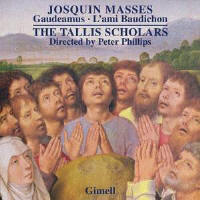Texte paru dans: / Appeared in: |
|
|
Outil de traduction ~ (Très approximatif) |
|
|
Reviewer: J.
F. Weber
Peter Phillips has now
recorded 14 of Josquin des Prez’s Masses on seven CDs, the largest such
collection ever. It appears that he will record four more Masses before the
quincentenary year of 1521, but not two others formerly attributed to him
that are clearly spurious. Of the two on this disc, Missa L’ami budichon has
been recorded by Peter Urquhart (not reviewed here) and Tetsuro Hanai
(herewith). Missa Gaudeamus has been recorded six times as far back as 1970,
but the discs have not been widely available. Of the two earliest, Roger
Cotte’s was reissued on CD, but Alejandro Planchart’s was not. The excellent
Rebecca Stewart version on Jubal and Bernard Fabre-Garrus’s were not
reviewed here, while Walter Testolin (30:1) and Maurice Bourbon (37:5)
received favorable treatment.
Phillips clearly appreciates
the contrast between high art and low art, one Mass based on the chant
introit for the feast of All Saints, the other based on a vulgar French song
and possibly the first Mass that he composed. Phillips offers an unusually
astute understanding of the details of both compositions, the kind of
analysis that might well be demanded of every recording of unfamiliar
examples of early music. He uses two voices to a part except for an extra
voice on the tenor line, the sort of ensemble that has usually characterized
the Tallis Scholars in their 45 years.
Missa Gaudeamus is preceded by
the antiphon of the chant introit on which it is based. Although Phillips
describes it as the introit for All Saints, the singers use the version for
the solemnity of the Blessed Virgin. In fact, the chant was originally
assigned to St. Agatha, and the text is adjusted for many saints and for
many feasts of the Blessed Virgin. Since Josquin uses only the first six
notes (setting the first word, “Gaudeamus”), the later parts of the text are
irrelevant. Another oddity is the artwork, a Memling triptych that isn’t
related to either Mass. He was an older contemporary of the composer, a
German who lived in Bruges and painted in the Flemish tradition.
The Baudichon Mass is an early
work that is more interesting than its neglect would suggest. In the notes
Phillips discusses its features with clarity and appreciation. The
comparison with Hanai’s version is close, for his tempos are similar to
Phillips’s, a shade faster in the Kyrie and Agnus Dei, slightly slower in
the middle movements. Hanai uses a mild form of period pronunciation
judiciously. His dynamic range is slightly narrower, noticeably in climaxes.
His eight voices blend like a choir, while Phillips’s singers, perhaps
caught up closer, are more individual. Either version would satisfy the gap
in the record catalog. As in their previous disc, Gimell provides 36 tracks
for the whole disc, giving more immediate access to sections of each
movement. Both Masses are sung from the New Josquin Edition, and the chant
introit was edited from manuscripts for the recording. This is a splendid
addition to this series. After comparing Tetsuro Hanai’s first Mass with Peter Phillips’s new version, it should be noted that the Biscaye Mass was also recorded several years before Phillips’s version (41:2), though I did not know it at the time of that review. Both were recorded in 2012, the sixth and most recent disc in Hanai’s series of Josquin Masses for a total of 12 Masses. This disc contains only the second recording of each Mass (Phillips made the third recording of each on separate issues). This Mass is closer to the Phillips interpretation. His tempos are only seconds faster than Phillips’s until the Agnus Dei, which is somewhat faster. Otherwise, the comparisons are the same. These two series of Josquin Masses are so similar that, for Western collectors, Hanai’s notes in Japanese make a big difference to the excellent notes that Phillips provides. Voracious collectors will not worry about that. Hanai enjoys fine engineering and production values. The cover art for two Masses that are parodies of secular love songs is appropriately taken from Le Roman de la Rose (British Library, Harley 4425). | |
|
|
|
|
Cliquez l'un ou l'autre
bouton pour découvrir bien d'autres critiques de CD |
|




